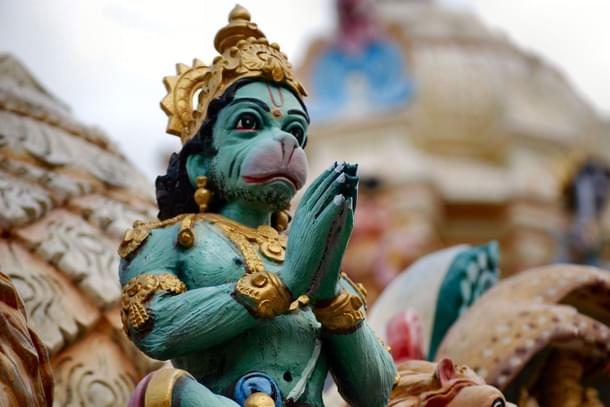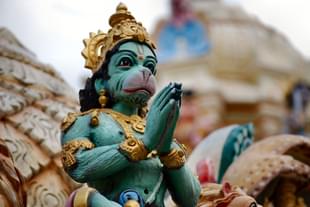Commentary
The Three Leaps of Hanuman: Valuable Insights For The Inner Growth Of Every Human Being
Aravindan Neelakandan
Dec 23, 2022, 04:17 PM | Updated Dec 29, 2022, 04:43 PM IST
Save & read from anywhere!
Bookmark stories for easy access on any device or the Swarajya app.


One of the most beloved deities for us Hindus is Hanuman. Children adore him. Adults worship him. Warriors evoke him. To women, he is the protector supreme. To Hindus, he personifies matchless might and endless wisdom, unbelievable strength and unsurpassed devotion.
Picturising Hanuman in our minds, we often remember him leaping. And three leaps stand prominent. His leap across the space to catch the sun; His leap across the ocean in search of Mother Sita and across the land mass of India to Himalayas, to serve Rama and Lakshmana.
These three are his mighty leaps, and each of these leaps carry valuable insights for the inner growth of every human being.

A child is curious. It explores. At the same time a child is also helpless. Its sense of wonder, without preconceptions, is its strength. It has the capacity to leap. It does leap. But there is also the danger of the very real world around us. It can hurt itself.
In fact every child when it ventures out from the comfort of its home and the lap of its mother, is bound to get hurt. Yet the child should explore and explore bravely. The good parentage is to heal the child when it gets hurt during its leap. It is not to arrest the leap. It is to heal the wounds the child may receive.
And we learn that it is from the same sun, whom Hanuman as a child thought as just a fruit, that he learnt all the scriptures and sciences. Sun became the Guru.
The child like wonder and the daring leap gave Hanuman not just the hurt, but more importantly gave him divine powers and wisdom. He learnt.
We too have delusional innocent conception of nature like, for example, belief in a magical reality or mechanical determinism – flawed perception of nature. Then when we leap based on that false notion, we get hurt. But from there, we learn.
We need to let go of the anthropocentric conception of nature and learn from the true nature. Then we gain the real knowledge that bestows us with god-like powers.
Meanwhile the parents should create an atmosphere that allows exploration and provides healing in case of a fall. We learn from this leap, the need to be a fearless gatherer of knowledge and wisdom.
Then comes the leap across the ocean.

Now all the knowledge that Hanuman has and his powers lie dormant, forgotten. The powers in the hands of a mischievous juvenile monkey, exhibiting the arrogance of power with its inability to respect wisdom, got cursed by the Rishis.
Often when we discover a new truth or invent a new technology we get that arrogance. It is the arrogance of reductionist technology. We know how to edit DNA and we know how to explore the surface of Mars. What use is the wisdom of the ancients?
Then comes a pandemic. It shows us the limits of technology and the need to further go deeper into the knowledge we have. We need to have humility. The curse is to make the arrogant go and in its place, a mature mighty warrior of truth and light emerge.
Jambawan plays the ideal teacher to bring out the mightiness within. Hanuman realizes his true potential and makes the leap across the ocean.
Here the powers and knowledge gained from the earlier leap towards the sun, become the tools for Ram Seva.
In this leap Hanuman encounters very interesting obstacles.
The first is in the form of a mountain that asks Hanuman to rest. Hanuman deserves the rest. It is the mountain’s indebtedness to Hanuman’s divine father Vayu. Hanuman declines this hereditary entitlement because it interferes with Ram Seva.
Then comes the mother of serpents. That which enters the domain should pass into her mouth. She is a challenge to Hanuman, to both his intelligence and power. Through his Yogic powers Hanuman victoriously enters her mouth — thus fulfilling the condition and swiftly moves out.
Now comes the third challenge — not from an external source alone. His own shadow is caught and he falls. But he emerges devouring Simhika, the catcher of shadows, from within and victoriously leaps back into his flight.
And the Devas rejoice his emergence and attribute it to four virtues Hanuman possesses: ‘firmness, vision, wisdom and dexterity.’
We realise through this leap how to dedicate our knowledge and power to the Divine and the challenges we shall face in our quest.
Then there is the leap for the mountain of healing and life-restoring herbs.

Now the target is known. Lanka. Enemy is clearly identified — Ravana. The battle is at hand. It is progressing. We are in the middle of the battle. It is the battle for Sri Rama and hence for Dharma.
In our popular imagination, this leap is associated with Hanuman bringing Sanjeevini for saving Lakshmana. In the Valmiki Ramayana although, the bringing of the mountain happens when the weapons of deceit and veiling have all the mighty warriors pierced and they have all fallen in depressing, despairing darkness.
And from the darkness, Jambavan asks for Hanuman — not for Rama and Lakshmana or Sugreeva, the king of the apes, but, Hanuman.
Vibeeshana and Hanuman alone are standing and it is for Hanuman that Jambavan calls. When Vibeeshana asks why, Jambavan says :
If that brave one is alive, even if this army has been destroyed, we will be alive. If Hanuman has lost his life, even if we are alive, we will be as good as dead.(Bibek Debroy translation)
That is a great statement. Nothing matches the greatness of a mighty selfless devotee who has completely surrendered to the Divine and Dharma.
If Mahavira lives then never the cause of Dharma is lost, despite the darkest of the times. Hanuman leaps across the ocean and goes to the Himalayan ranges.
There, Hanuman sees the mineral treasures blazing, including gold and rare gems. He sees the Divine Gods, their abodes. He sees the hermitages of Rishis in serene settings. But Hanuman has a determined mission and vision only for that mission. Leave alone the material treasures, even serenity of spiritual peace could not make him waver from his goal.
Between the summits of Rishabha and Kailasa, he looks for the radiant herbs in the mountain summit. The herbs made themselves invisible. So Hanuman took the entire mountain and brought it to the place where the warriors of Dharma lay fainted.
Once they are healed and rejuvenated, Hanuman returns the mountain to its original place. Later when Meghnad attacks Lakshmana in a near fatal manner, Hanuman is asked to hurry back and fetch the herbs again and this time too, he fetches the mountain.
Here too, the leap is to save a life within a time constraint and in the middle of the battle. If in the first two leaps Hanuman was partaking in child’s play and then a lone mission, now he is part of the team work of warriors for Sri Rama. So he fetches the entire mountain and lets the medicinal professionals take over.
All the three leaps of Hanuman, each different in his life, and each distinct in the context, has a life lesson for an individual in search of truth and in his or her war for Dharma.
Acquiring knowledge, utilising the knowledge for Dharma and Seva, using the power of the individual, however mighty, in right accordance with team work and in all these, not letting ego and other negativities consume one’s spiritual core — we can learn all these from Hanuman, the Mahaveera.
No wonder Swami Vivekananda asked the nation to make Hanuman the national ideal for Rashtra Seva: "As on the one hand Hanuman represents the ideal of service, so on the other he represents the leonine courage, striking the whole world with awe. He has not the least hesitation in sacrificing his life for the good of Rama. A supreme indifference to everything except the service of Rama, even to the attainment of the status of Brahman or Shiva, the great World-Gods! Only the carrying out of Shri Rama‘s behest is the one vow of his life! Such whole-hearted devotion is wanted."




